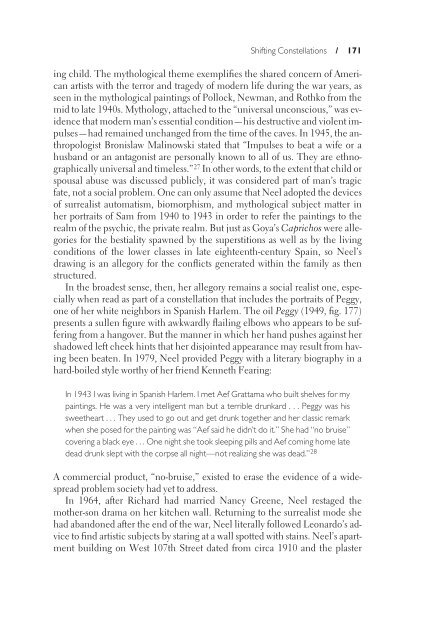i-xxii Front matter.qxd - Brandeis Institutional Repository
i-xxii Front matter.qxd - Brandeis Institutional Repository
i-xxii Front matter.qxd - Brandeis Institutional Repository
Create successful ePaper yourself
Turn your PDF publications into a flip-book with our unique Google optimized e-Paper software.
Shifting Constellations / 171ing child. The mythological theme exempliƒes the shared concern of Americanartists with the terror and tragedy of modern life during the war years, asseen in the mythological paintings of Pollock, Newman, and Rothko from themid to late 1940s. Mythology, attached to the “universal unconscious,” was evidencethat modern man’s essential condition—his destructive and violent impulses—hadremained unchanged from the time of the caves. In 1945, the anthropologistBronislaw Malinowski stated that “Impulses to beat a wife or ahusband or an antagonist are personally known to all of us. They are ethnographicallyuniversal and timeless.” 27 In other words, to the extent that child orspousal abuse was discussed publicly, it was considered part of man’s tragicfate, not a social problem. One can only assume that Neel adopted the devicesof surrealist automatism, biomorphism, and mythological subject <strong>matter</strong> inher portraits of Sam from 1940 to 1943 in order to refer the paintings to therealm of the psychic, the private realm. But just as Goya’s Caprichos were allegoriesfor the bestiality spawned by the superstitions as well as by the livingconditions of the lower classes in late eighteenth-century Spain, so Neel’sdrawing is an allegory for the con„icts generated within the family as thenstructured.In the broadest sense, then, her allegory remains a social realist one, especiallywhen read as part of a constellation that includes the portraits of Peggy,one of her white neighbors in Spanish Harlem. The oil Peggy (1949, ƒg. 177)presents a sullen ƒgure with awkwardly „ailing elbows who appears to be sufferingfrom a hangover. But the manner in which her hand pushes against hershadowed left cheek hints that her disjointed appearance may result from havingbeen beaten. In 1979, Neel provided Peggy with a literary biography in ahard-boiled style worthy of her friend Kenneth Fearing:In 1943 I was living in Spanish Harlem. I met Aef Grattama who built shelves for mypaintings. He was a very intelligent man but a terrible drunkard . . . Peggy was hissweetheart . . . They used to go out and get drunk together and her classic remarkwhen she posed for the painting was “Aef said he didn’t do it.” She had “no bruise”covering a black eye . . . One night she took sleeping pills and Aef coming home latedead drunk slept with the corpse all night—not realizing she was dead.” 28A commercial product, “no-bruise,” existed to erase the evidence of a widespreadproblem society had yet to address.In 1964, after Richard had married Nancy Greene, Neel restaged themother-son drama on her kitchen wall. Returning to the surrealist mode shehad abandoned after the end of the war, Neel literally followed Leonardo’s adviceto ƒnd artistic subjects by staring at a wall spotted with stains. Neel’s apartmentbuilding on West 107th Street dated from circa 1910 and the plaster
















